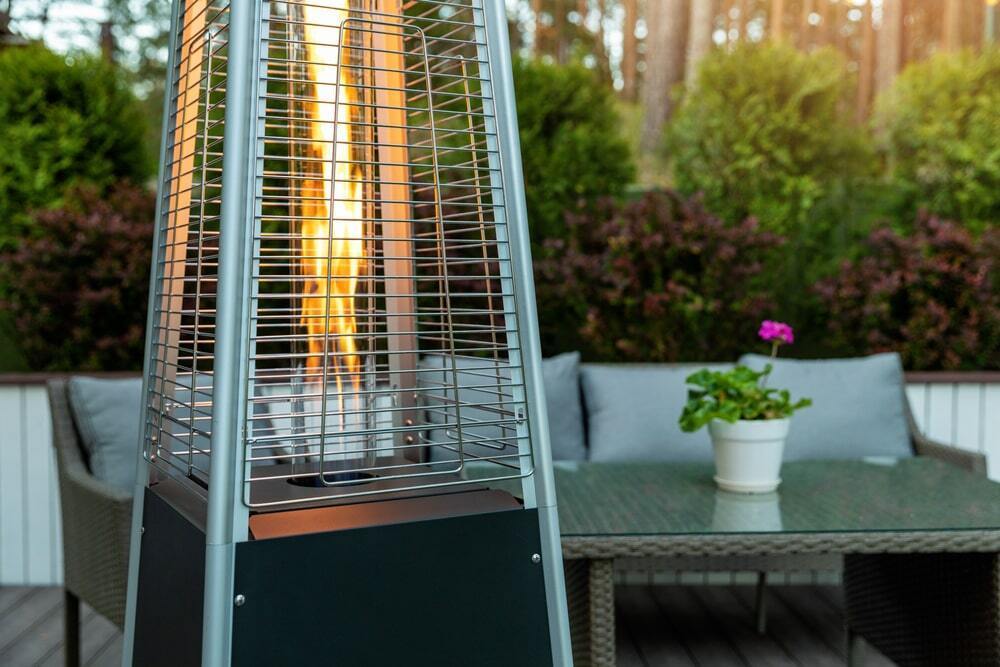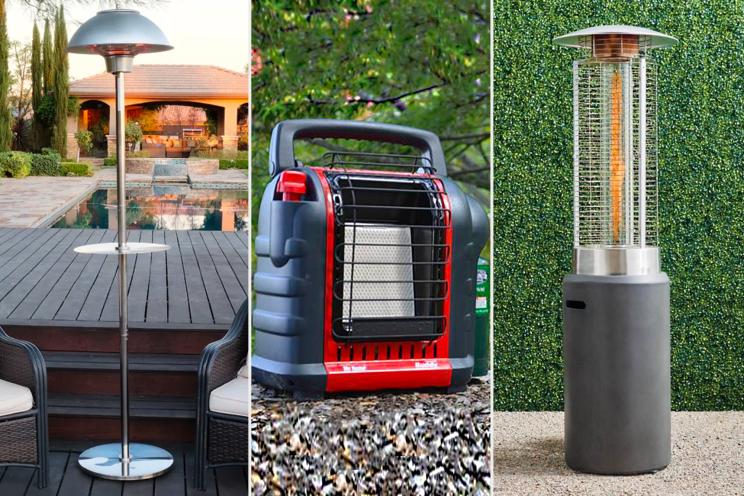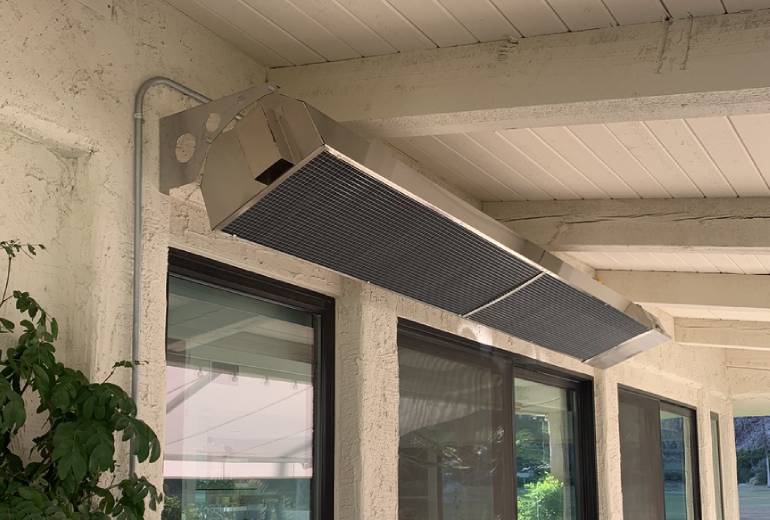What is a Patio Heater?
A patio heater is a popular way to keep your outdoor space warm and cozy during colder seasons. It is typically a standalone heating appliance that is portable and can be used in outdoor spaces like verandas, decks, and patios. Patio heaters come in various sizes and shapes, including electric and liquid propane models. These devices can provide heat to a small or large outdoor gathering area, making it comfortable enough for people to stay outside for longer periods. Patio heaters work by emitting heat through radiation or convection, depending on the type. In the following section, we will dig deeper into how patio heaters work and the factors that affect its heating efficiency.
How Does a Patio Heater Work?

Patio heaters come in different forms, including electric, natural gas, and propane-powered models. Each model type has its unique advantages and functions, making them suitable for varying outdoor situations and preferences.
Regardless of the type, a patio heater typically consists of the same primary components. These components include the heat source, burner, reflector, pressure regulator, and fuel supply (tank or line).
The heat source is what generates the heat, and this can vary depending on the type of patio heater. In electric models, the heat source is one or more electric bulbs responsible for providing heat. Gas-powered models use a gas burner to provide the heat, while propane-powered models have a propane burner.
The burner sits above the reflector, which is a heat-resistant surface that reflects the heat downwards. The reflector ensures that heat is evenly distributed throughout the outdoor space for maximum heating efficiency.
The pressure regulator ensures that the burner receives the appropriate amount of fuel to produce the desired level of heat output. This component regulates the fuel’s pressure, preventing it from being too high or too low.
Lastly, the unit’s fuel supply can either be in the form of a propane tank or a natural gas line. Propane tanks are the most common type of fuel supply for most patio heaters, and they come in different sizes, including 20-pound tanks that can provide up to 18-20 hours of heat on a medium setting.
Overall, a patio heater works by producing heat from a heat source, which is then distributed evenly through a reflector and regulated by the pressure regulator. The type of patio heater and its components play a significant role in determining its heating efficiency and ability to provide heat for varying outdoor spaces and conditions.
Types of Patio Heaters

When it comes to outdoor heating options, patio heaters offer a convenient and efficient way to keep your outdoor space warm and cozy during chilly evenings. There are various types of patio heaters available today, including propane, electric, and natural gas patio heaters. Each type of patio heater has its unique features and benefits, making it suitable for different situations and preferences. In the following sections, we’ll explore the key characteristics of each of these popular types of patio heaters.
Propane Patio Heaters

Propane patio heaters are a popular and effective way to keep your outdoor space warm and comfortable during cool or chilly evenings. These heaters use propane gas to generate heat, providing an intense and consistent source of warmth. There are two primary types of propane patio heaters – stationary propane tanks and portable patio heaters with fuel tanks.
Stationary propane tanks are ideal for larger outdoor areas that require heating, such as open-air dining spaces or patios. These propane patio heaters can reach heights of up to 7 feet and can provide heat output of up to 46,000 British Thermal Units (BTUs) per hour. They are typically designed with a center post that supports the heat-emitting head and can come in original or permanent styles.
Portable propane patio heaters, on the other hand, are perfect for smaller outdoor spaces and are designed to provide intense heat and greater portability. These heaters are usually lightweight and come with a fuel tank attached to the base, which makes them easy to move around without worrying about power cords or electrical outlets.
One of the significant benefits of using propane patio heaters over other types of patio heaters, such as natural gas heaters or electric patio heaters, is their greater heating efficiency. Propane gas is an efficient fuel source that generates intense heat, and it doesn’t depend on electricity to operate. This means that even during power outages, propane patio heaters will continue to work and keep your space warm.
Propane patio heaters are also highly portable, which makes them ideal for outdoor spaces that require flexibility and mobility. They can be taken to different locations, such as camping trips or outdoor events, and set up quickly and easily using a pressure regulator and a propane tank.
Finally, one of the most crucial aspects of propane patio heaters is their safety features. These heaters are designed with several safety features, such as anti-tip-over systems and automatic shut-off valves, which ensure that they are safe to use and operate. Additionally, propane gas is stored in a secure and sturdy tank, reducing the risk of any accidents or spills.
Overall, propane patio heaters offer an efficient and portable way to enhance your outdoor space’s heating abilities, making them an excellent investment for any homeowner or outdoor enthusiast.
Electric Patio Heaters

Electric patio heaters are a great alternative to propane patio heaters, offering a range of benefits that make them an attractive option for many homeowners. These types of heaters use electricity as their primary power source, making them more cost-effective and environmentally friendly than their propane counterparts.
One of the primary benefits of electric patio heaters is their efficiency. These heaters convert all of the energy they draw from the electrical supply into heat, minimizing any wasted energy and reducing your energy bills in the process. Plus, since electricity is much less expensive than propane, using an electric patio heater can save you money over the long term.
Another significant advantage of electric patio heaters is their minimal environmental impact. Unlike propane patio heaters, electric heaters do not generate harmful emissions that can damage the environment or affect air quality. This makes them a much more sustainable option for homeowners who are looking to reduce their carbon footprint and create a more eco-friendly outdoor living space.
There are several different types of electric patio heaters available on the market today, each with its unique features and benefits. Standing models are among the most popular, offering a versatile and portable heating solution for outdoor spaces. Wall-mounted models, on the other hand, are ideal for smaller patios or areas where floor space is limited, while tabletop models can be easily moved around as needed.
When it comes to heating efficiency, electric patio heaters are generally less powerful than propane heaters, but they can still deliver a substantial amount of heat to your outdoor living space. Electric heaters typically range from 500 to 1500 watts, with larger models capable of generating up to 5000 watts of heat output. While they may not be as powerful as propane heaters, electric patio heaters can still provide effective heating for most outdoor areas.
Finally, when using electric patio heaters, it is important to take certain safety precautions to ensure your outdoor living space is safe and secure. Always be sure to keep the heater away from any flammable materials, and never leave it unattended while it is in use. Additionally, be sure to read the manufacturer’s instructions carefully and follow all recommended safety guidelines to prevent any accidents or injuries.
Natural Gas Patio Heaters

When it comes to choosing a patio heater, natural gas options are becoming increasingly popular due to their numerous benefits and features. Compared to propane and electric heaters, natural gas patio heaters offer consistent heat output, an unlimited fuel supply, and efficient heating for outdoor areas, making them a popular choice for homeowners.
One of the primary advantages of natural gas patio heaters is their consistent heat output. Unlike propane heaters, which can run out of fuel mid-use and cause fluctuations in heat, natural gas heaters offer a steady and reliable heat source for outdoor spaces. This can be particularly beneficial in colder months when a consistent heat source is needed to keep outdoor living areas warm and comfortable.
Another significant benefit of natural gas patio heaters is their unlimited fuel supply. Since these heaters are connected to a natural gas line, there’s no need to worry about constantly replacing propane tanks or recharging electric heaters. This makes them a practical and cost-effective option for homeowners, especially those who frequently use their outdoor living areas.
Natural gas patio heaters come in various types, including stationary and portable options. Stationary heaters are typically larger and can be installed permanently, making them a good choice for homeowners with larger outdoor spaces. Portable heaters, on the other hand, are smaller and more versatile, making them a popular choice for those who want to move their heaters around as needed or take them on camping trips.
However, installing a natural gas patio heater requires professional assistance, as it involves connecting the heater to your gas line. Homeowners must ensure that they have a gas line installed and connected to their outdoor living area before purchasing a natural gas patio heater. Professional installation is typically required for this to ensure proper connections and safe use of the appliance.
Overall, natural gas patio heaters are a practical and efficient option for homeowners looking for consistent heat output and an unlimited fuel supply. With various stationary and portable options available, these heaters can be used to create a warm and comfortable outdoor living space all year round.
How Long Can a 20 lb Propane Tank Last on a Patio Heater?
When using a propane patio heater, the duration of use with a 20 lb propane tank can vary depending on several factors. These factors can include the heat output of the patio heater, wind conditions, and the propane consumption rate of the appliance itself. Understanding these factors can help you predict the amount of time a 20 lb propane tank will last when used with your patio heater, allowing you to properly plan and budget for your outdoor heating needs.
Factors That Affect the Duration of Use with a 20 lb Tank
The duration of use with a 20 lb tank on a patio heater can be influenced by several factors. One of the most important factors is the heating efficiency of your patio heater. Patio heaters with a good heating efficiency can transfer more heat to the surrounding area, making the heating process more effective and increasing the duration of use with a 20 lb propane tank.
Another factor that can affect the duration of use is wind conditions. Windy conditions can impact the amount of heat that is transferred from the patio heater to the surrounding area, decreasing its effectiveness and shortening the duration of use. Therefore, it is crucial to take wind conditions into account when determining the amount of propane required for your patio heater.
The intensity of heat required is another factor that can impact the duration of use with a 20 lb propane tank. When a higher intensity of heat is desired, the consumption of propane is greater, decreasing the duration of use of the tank. Meanwhile, lower intensity heat requires less energy and, as a consequence, propane usage is lower, increasing the duration of use.
Other factors to consider may include the size of your outdoor space and whether your patio heater has safety features such as an automatic shut-off mechanism in case of tip-over or strong winds.
It’s also worth noting that the duration of use with a 20 lb tank can vary significantly between colder months and milder seasons. During colder months, patio heaters are possibly required to run for more extended periods, reducing the time that the tank lasts. In contrast, patio heaters need less energy to operate during milder seasons, which extends the duration of use.
Lastly, the BTUs per hour of your patio heater or the size of your average propane tank per month of use can influence the duration of use with a 20 lb propane tank. Therefore, it’s important to measure your propane usage to avoid running out of fuel when you need it the most.




